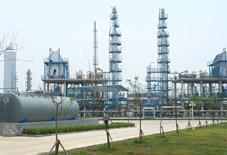As a Formaldehyde Production Plant, share with you.
01 Physical Law
1. Precipitation method: mainly remove inorganic particles and SS in waste
water 2. Filtration method: mainly remove SS and oily substances in waste water
3. Oil separation: remove floatable oil and dispersed oil 4. Air floatation
method: separation of oil and water, useful substances Recovery and suspended
solids with a relative density close to 1 (the density of water is approximately
1) 5. Centrifugal separation: removal of tiny SS 6. Magnetic separation: removal
of SS and colloids that are difficult to remove by precipitation
02 Chemical Law
1. Coagulation and precipitation method: remove colloid and fine SS2.
Neutralization method: treatment of acid and alkali wastewater 3. Oxidation
reduction method: removal of toxic and difficult biodegradable substances 4.
Chemical precipitation method: heavy metal ions, sulfur ions, sulfuric acid Root
ion, phosphate, ammonium, etc. removal
03 Physical Chemistry Method
1. Adsorption method: a small amount of heavy metal ions, hardly
biodegradable organic matter, decolorization and deodorization, etc. 2. Ion
exchange method: recovery of precious metals, radioactive waste water, organic
waste water, etc. 3. Extraction method: hardly biodegradable organic matter,
heavy metal ions, etc. 4. Stripping and stripping: removal of solubility and
volatile substances.
04 Biological Law

Formaldehyde Production Plant
1. Activated sludge method:
A general term for various methods of micro-organism suspended in water in
wastewater biological treatment.
(1) SBR method Sequencing Batch Reactor Activated Sludge Process (Sequencing
Batch Reactor Activated Sludge Process) is an abbreviation of activated sludge
sewage treatment technology that operates by intermittent aeration, also known
as sequential batch activated sludge method . The core of SBR technology is the
SBR reaction tank, which integrates the functions of homogenization, primary
settling, biodegradation, secondary settling, etc. into one tank without a
sludge return system. Advantages: 1) Simple process and cost saving 2) Ideal
push flow process makes the biochemical reaction with high thrust and high
efficiency 3) Flexible operation mode, good effect of nitrogen and phosphorus
removal 4) The best process to prevent sludge expansion 5) Impact resistance
Strong load and handling capacity
(2) CASS method The CASS method is an improved version of the SBR method,
characterized by small footprint, low operating costs, mature technology, and
stable process. The CASS method is to set a biological selection area in the
front of the CASS reaction tank, and an automatic decanting device that can be
raised and lowered in the rear. (3) AO method AO process method is also called
anaerobic aerobic process method, A (Anacrobic) is an anaerobic section, used
for nitrogen and phosphorus removal; O (Oxic) is an aerobic section, used to
remove organic matter in water. Advantages: 1) The system is simple, the
operating cost is low, and the floor space is small. 2) The carbon-containing
organic matter and endogenous metabolites in the raw sewage are used as the
carbon source, which saves the cost of adding an external carbon source. Organic
matter can be further removed 4) The anoxic tank comes first, because
denitrification consumes part of the carbon source organic matter, which can
reduce the load of the aerobic tank 5) The alkalinity generated by
denitrification can compensate for the alkalinity consumption of the
nitrification process
Our company also has Silver Catalyzed Formaldehyde Plant for sale, please
contact us.














